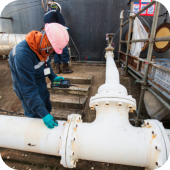

Scotia NDT Services ltd
Scotia NDT Services Ltd was established in 2015 and has created a reputation for quality and reliability within the industry sectors it currently operates.
Overview
Working within its scope of BS EN ISO 9001:2015 and being members of both The British Institute of Non-Destructive Testing (BINDT) and The Safety Assessment Federation (SAFed) they can provide Non-Destructive Testing services and Weld Inspection, either at their purpose-built facility in Annan in Dumfries & Galloway or onsite quickly and reliably throughout the UK.
Services we offer:
- Weld Inspection
- Magnetic Particle Inspection: Bench and Portable Equipment
- Penetrant Inspection: Pen Line and Portable Equipment
- Ultrasonic Testing (Castings, Forgings & Welds)
- Visual Testing (Castings, Forgings & Welds)
- Positive Material Identification
- Hardness Testing
- Level 3 Consultancy Services
Scotia NDT Services ltd vastly experienced technicians offer a high degree of expertise and technical knowledge which allows them to support all industry sectors including Fasteners, Fabrication, Engineering, Oil and gas, Petrochemical, Renewable, Automotive, Construction, and Defence.
Products
Services
Ads












